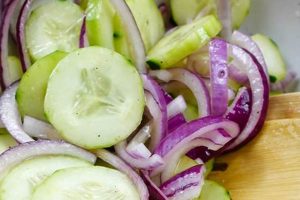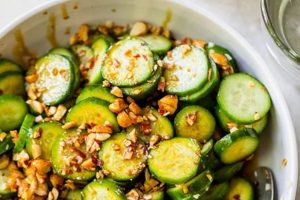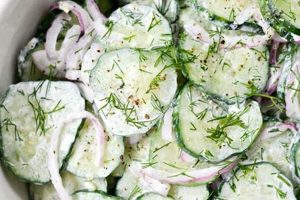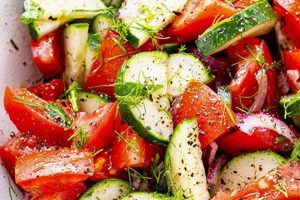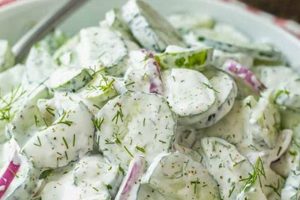A refreshing and vibrant dish, typically composed of thinly sliced or diced beets and cucumbers, often combined with other ingredients such as onions, fresh herbs (dill, mint), and a tangy dressing (vinegar, lemon juice). Variations may include feta cheese, yogurt, or other additions to enhance flavor and texture. A simple preparation offers a nutritious and flavorful complement to diverse meals.
This colorful combination offers nutritional benefits from both root and garden vegetables. Beets provide essential nutrients like nitrates, which can contribute to heart health, while cucumbers offer hydration and antioxidants. Historically, both vegetables have been cultivated for centuries, appearing in various culinary traditions across the globe. The simplicity and adaptability of such dishes have ensured their continued popularity as a healthy and flavorful option.
This introduction provides a foundation for exploring various aspects of creating and enjoying this culinary delight. Topics to be covered could include the selection and preparation of ingredients, different dressing options and flavor profiles, nutritional information, and serving suggestions. Variations for diverse dietary needs and preferences will also be considered.
Tips for a Perfect Beet and Cucumber Salad
Creating a delightful beet and cucumber salad involves attention to detail. The following tips ensure optimal flavor, texture, and visual appeal.
Tip 1: Selecting Ingredients: Opt for firm, unblemished beets and cucumbers. Smaller beets tend to be more tender. Consider using different beet varieties (golden, chioggia) for varied color and flavor.
Tip 2: Preparation Techniques: Roasting beets intensifies their sweetness. Alternatively, boiling or steaming can be employed. Peel and slice beets thinly or dice them evenly. Cucumbers can be peeled, seeded, and sliced or diced to match the beet preparation.
Tip 3: Balancing Flavors: The earthy sweetness of beets pairs well with acidic elements. Consider a vinaigrette with lemon juice, red wine vinegar, or a combination. A touch of sweetness (honey, maple syrup) can further enhance the balance.
Tip 4: Enhancing Texture: Incorporating textural contrast elevates the salad. Toasted nuts, crumbled feta cheese, or a sprinkle of toasted sesame seeds provide satisfying variety.
Tip 5: Fresh Herbs: Fresh dill or mint complements the flavors of beets and cucumbers. Other herbs, such as parsley or chives, can also be considered.
Tip 6: Timing and Chilling: Allowing the salad to chill for a short time allows the flavors to meld. However, avoid excessive chilling, as it can diminish the vibrancy of the vegetables.
Tip 7: Presentation: Thoughtful plating enhances the dining experience. Arrange the salad attractively on a serving dish, garnishing it with fresh herbs or a sprinkle of the chosen dressing.
By following these guidelines, one can achieve a beet and cucumber salad that is both visually appealing and delectable. The combination of fresh, high-quality ingredients and careful preparation techniques results in a truly satisfying culinary experience.
These practical tips provide a pathway to achieving culinary excellence. The following section will offer concluding thoughts and serving suggestions.
1. Ingredient Selection
Ingredient selection significantly impacts the final quality and flavor profile of a beet and cucumber salad. Choosing fresh, appropriately ripe produce and complementary additions forms the foundation of a successful dish. The following facets explore key considerations for ingredient selection.
- Beets:
Beets offer diverse varieties, each contributing unique characteristics. Red beets provide earthy sweetness and vibrant color; golden beets offer a milder, slightly sweeter flavor; chioggia beets (candy cane beets) present a beautiful interior swirl of red and white. Selecting firm beets with smooth skins, free from blemishes, ensures optimal quality. Size also matters; smaller beets are generally more tender.
- Cucumbers:
Cucumbers provide a refreshing counterpoint to the sweetness of beets. English cucumbers, known for their thin skin and minimal seeds, offer a delicate flavor. Persian cucumbers, smaller and slightly sweeter, are another excellent choice. Garden cucumbers, the most common variety, require peeling and seeding to remove potential bitterness. Selecting firm cucumbers with vibrant green skin ensures optimal freshness and flavor.
- Complementary Ingredients:
Additional ingredients enhance the overall composition of the salad. Red onion adds a pungent bite, while fresh herbs like dill and mint provide aromatic complexity. Feta cheese contributes a salty, tangy element, while toasted nuts, such as walnuts or pecans, offer textural contrast. These additions, chosen carefully, elevate the salad from simple to sophisticated.
- Dressing:
The dressing binds the ingredients and contributes significantly to the final flavor profile. A simple vinaigrette with lemon juice, red wine vinegar, or a combination provides the necessary acidity to balance the sweetness of the beets. A touch of sweetness (honey, maple syrup) and quality olive oil complete the emulsion. Other options include yogurt-based dressings for a creamier texture.
The careful selection of each ingredient contributes to the overall harmony and balance of the beet and cucumber salad. Considering the unique characteristics of each component, from the variety of beets to the type of dressing, ensures a final product that is both visually appealing and delectable. Harmonizing these elements creates a salad that offers a delightful balance of flavors, textures, and colors.
2. Preparation Methods
Preparation methods significantly influence the flavor, texture, and overall quality of a beet and cucumber salad. Different techniques applied to the core ingredients yield distinct characteristics, impacting the final culinary experience. Understanding these methods allows for informed decisions tailored to specific preferences and desired outcomes.
Beet Preparation: Roasting beets intensifies their natural sweetness and concentrates their flavor, producing a tender, almost caramelized texture. Boiling or steaming retains a brighter color and a slightly firmer texture. Pickling beets adds a tangy dimension and extends their shelf life. Each method imparts unique characteristics; the choice depends on the desired flavor profile and the overall composition of the salad. For instance, roasted beets pair well with bolder flavors like goat cheese and walnuts, while boiled beets complement lighter vinaigrettes and fresh herbs.
Cucumber Preparation: Cucumbers, offering a refreshing coolness, benefit from specific preparation techniques. Thinly slicing or dicing cucumbers ensures even distribution throughout the salad and facilitates flavor absorption from the dressing. Seeding cucumbers removes excess moisture and reduces potential bitterness, particularly relevant for garden cucumbers. Salting and draining sliced cucumbers further reduces moisture, resulting in a crisper texture and preventing the salad from becoming watery. This step is especially crucial when preparing the salad in advance.
The interplay between beet and cucumber preparation methods shapes the final character of the salad. Harmonizing these techniques is essential for creating a balanced and flavorful dish. A salad featuring roasted beets and thinly sliced, salted cucumbers, for instance, offers a combination of sweet, earthy notes and refreshing crispness. Conversely, a salad with pickled beets and diced cucumbers provides a tangy, vibrant experience. Understanding these nuances empowers informed choices, leading to a more satisfying culinary outcome.
3. Flavor Balancing
Flavor balancing is paramount in a successful beet and cucumber salad recipe. The inherent sweetness of beets necessitates a counterpoint; this interplay creates a harmonious flavor profile. Acidity, often introduced through vinegar or citrus juice, provides the necessary contrast, preventing the sweetness from becoming overwhelming. The type of acid employed contributes further complexity. Lemon juice offers brightness, while red wine vinegar introduces subtle fruitiness. The concentration of acid must be carefully calibrated to complement the beets’ sweetness without overpowering the other ingredients. For example, a salad with golden beets, known for their mild sweetness, benefits from a lighter vinaigrette, whereas robust red beets can withstand a more assertive acidic component. This careful consideration of contrasting flavors elevates the dish from merely palatable to genuinely delightful.
Beyond acidity, other elements contribute to flavor balancing. Salty components, such as feta cheese or a sprinkle of sea salt, enhance the overall complexity and further temper the sweetness. The addition of fresh herbs introduces aromatic notes and textural variety. Dill, with its slightly anise-like flavor, complements the earthy notes of beets, while mint provides a refreshing counterpoint. The quantity of herbs used should be judicious, enhancing the flavor profile without dominating it. For instance, a salad featuring roasted beets, crumbled feta, and fresh dill offers a well-balanced combination of sweet, salty, earthy, and herbaceous notes. This interplay of contrasting yet complementary flavors creates a multi-dimensional culinary experience.
Achieving flavor balance in a beet and cucumber salad hinges on understanding the interplay of different taste components. The inherent sweetness of beets serves as the foundation, while acidity, saltiness, and herbaceous notes provide the necessary counterpoints. Careful consideration of these elements, combined with appropriate ingredient selection and preparation methods, ensures a harmonious and satisfying final product. The practical significance of this understanding lies in the ability to create a dish that is not only visually appealing but also offers a complex and balanced flavor profile, showcasing the versatility and potential of this simple yet elegant salad.
4. Textural Contrast
Textural contrast contributes significantly to the enjoyment of a beet and cucumber salad. The inherent textures of beets and cucumbers, while pleasant, benefit from the incorporation of contrasting elements. Beets, whether roasted or boiled, offer a relatively smooth, sometimes yielding texture. Cucumbers, particularly when thinly sliced, provide a crisp, refreshing counterpoint. However, relying solely on these two textures can result in a somewhat monotonous sensory experience. Introducing contrasting textures elevates the salad, creating a more dynamic and engaging culinary experience. This can be achieved through various additions, each contributing a unique textural dimension.
Nuts, such as toasted walnuts, pecans, or sunflower seeds, introduce a satisfying crunch. The contrast between the smooth beets, crisp cucumbers, and crunchy nuts provides a delightful interplay of textures. Crumbled feta cheese contributes a creamy, slightly crumbly element, further diversifying the textural profile. Toasted sesame seeds offer a delicate crunch, while toasted coconut flakes provide a subtle chewiness. Even the addition of thinly sliced red onion introduces a slight sharpness, both in flavor and texture. The choice of textural additions depends on the overall composition of the salad and the desired balance of flavors. For example, a salad featuring roasted beets, crumbled goat cheese, and candied pecans offers a complex interplay of smooth, creamy, and crunchy textures, enhancing the overall sensory experience.
Understanding the role of textural contrast enables the creation of a more dynamic and satisfying beet and cucumber salad. The interplay of different textures enhances the enjoyment of the dish, transforming a simple combination of ingredients into a multi-dimensional culinary experience. The practical significance of this understanding lies in the ability to elevate a basic salad by incorporating readily available ingredients that contribute not only textural variety but also complementary flavors, resulting in a more complex and enjoyable final product.
5. Presentation Techniques
Presentation techniques significantly impact the perceived value and enjoyment of a beet and cucumber salad. Visual appeal enhances the dining experience, transforming a simple salad into an aesthetically pleasing culinary creation. Thoughtful presentation elevates the dish, stimulating appetite and adding a touch of elegance. The following facets explore key considerations for presenting beet and cucumber salads effectively.
- Color and Contrast:
The vibrant colors of beets and cucumbers provide a natural foundation for an attractive presentation. Employing contrasting colors enhances visual appeal. Deep red beets juxtaposed with the bright green of cucumbers create a striking visual contrast. Incorporating other colorful elements, such as orange segments, yellow bell peppers, or sprigs of fresh herbs, further amplifies the visual interest. The strategic arrangement of these elements creates a dynamic and appealing presentation, highlighting the natural beauty of the ingredients.
- Plating and Arrangement:
The choice of serving vessel and the arrangement of ingredients influence the overall presentation. A simple white plate provides a neutral backdrop, allowing the vibrant colors of the salad to stand out. Alternatively, a rustic wooden bowl adds a touch of earthiness, complementing the natural ingredients. Arranging the salad components thoughtfully, rather than simply tossing them together, enhances visual appeal. Consider layering the ingredients or creating a visually interesting pattern, showcasing the diverse textures and colors.
- Garnishing:
Garnishes provide the finishing touch, adding a touch of elegance and enhancing the sensory experience. A sprinkle of fresh herbs, such as dill or mint, complements the flavors of the salad while adding a touch of freshness. A drizzle of high-quality olive oil or a sprinkle of toasted nuts or seeds adds textural and visual interest. A dollop of crme frache or a sprinkle of crumbled cheese elevates the presentation, adding a touch of richness and complexity. The choice of garnish should complement the overall flavor profile and enhance the visual appeal of the salad. Over-garnishing can detract from the presentation; restraint and careful selection are key.
- Serving Temperature:
Serving temperature impacts both the flavor and the presentation of the salad. Chilling the salad enhances the refreshing qualities of the cucumbers and allows the flavors to meld. However, excessive chilling can dull the flavors and make the ingredients appear less vibrant. Serving the salad slightly chilled ensures optimal flavor and maintains the visual appeal of the ingredients. Consider the ambient temperature and the overall dining experience when determining the ideal serving temperature.
Effective presentation elevates the beet and cucumber salad from a simple dish to a visually appealing culinary creation. By considering color, plating, garnishing, and serving temperature, one can transform this humble salad into a visually stunning and appetizing dish. The interplay of these elements enhances the overall dining experience, showcasing the versatility and potential of this simple yet elegant salad.
6. Nutritional Value
Nutritional value represents a significant aspect of a beet cucumber salad recipe. This dish offers a combination of vitamins, minerals, and antioxidants, contributing to overall dietary health. Beets provide a rich source of nitrates, which can promote cardiovascular health by improving blood flow and lowering blood pressure. They also contain betalains, potent antioxidants with anti-inflammatory properties. Cucumbers offer hydration and contribute vitamins K and C, essential for blood clotting and immune function, respectively. The combined nutritional profile makes this salad a valuable addition to a balanced diet. For example, incorporating this salad into a lunch or dinner routine can increase vegetable intake, contributing to recommended daily allowances of essential nutrients.
The nutritional value of this salad can be further enhanced through ingredient selection and preparation methods. Using fresh, locally sourced produce maximizes nutrient content. Minimally processing ingredients, such as lightly steaming or roasting beets rather than boiling, helps retain vitamins and minerals. The choice of dressing also influences nutritional value. A light vinaigrette based on olive oil and lemon juice provides healthy fats and antioxidants, while avoiding excessive calories or unhealthy additives found in some commercial dressings. For instance, a dressing made with extra virgin olive oil contributes monounsaturated fats, beneficial for heart health. Careful consideration of these factors optimizes the nutritional benefits of the salad, aligning with dietary goals focused on health and well-being.
In conclusion, the nutritional value of a beet cucumber salad contributes significantly to its appeal as a healthy and flavorful dish. Understanding the specific nutrients provided by each ingredient, combined with informed choices regarding preparation and dressing, allows individuals to maximize the health benefits. This awareness empowers individuals to make informed dietary choices, integrating this nutrient-rich salad into a balanced eating pattern. The practical significance lies in promoting overall health and well-being through mindful consumption of nutrient-dense foods.
Frequently Asked Questions
This section addresses common inquiries regarding beet and cucumber salad preparation, offering practical guidance for optimal results.
Question 1: How can one prevent beets from bleeding excessively and staining other ingredients?
Roasting beets helps contain their color within the skin. Alternatively, adding a small amount of acid, such as vinegar or lemon juice, to the cooking water can help preserve color. Once cooked and sliced, tossing beets separately with a portion of the dressing can also minimize bleeding onto other ingredients.
Question 2: What are effective strategies for reducing the moisture content in cucumbers, preventing a watery salad?
Salting sliced cucumbers and allowing them to drain in a colander for approximately 15-20 minutes effectively draws out excess moisture. This step ensures a crisper texture and prevents the salad from becoming diluted. Patting the cucumber slices dry with a paper towel after draining further reduces moisture.
Question 3: Can this salad be prepared in advance?
The salad components can be prepared separately in advance. Store cooked beets, sliced cucumbers (after salting and draining), and dressing separately in airtight containers in the refrigerator. Combine ingredients shortly before serving to maintain optimal texture and prevent the salad from becoming watery.
Question 4: What are suitable alternatives to feta cheese for those seeking dairy-free options?
Crumbled goat cheese offers a tangy alternative with a distinct flavor profile. Vegan feta cheese options, typically made from tofu or cashews, provide a dairy-free alternative. Toasted nuts or seeds can also provide a comparable salty and textural element.
Question 5: How can one adapt the salad for different dietary preferences, such as low-carb or gluten-free?
This salad is naturally gluten-free. For low-carb variations, reduce the quantity of beets or omit them entirely. Focus on cucumbers and other low-carb vegetables, paired with a low-sugar dressing. Adjusting portion sizes allows adaptation to various dietary needs.
Question 6: What are optimal storage practices for leftover salad?
Store leftover salad in an airtight container in the refrigerator for up to 2 days. However, the texture of the cucumbers may soften slightly over time. It is generally recommended to consume the salad within 24 hours for optimal quality.
These frequently asked questions offer practical solutions to common challenges encountered during preparation. Understanding these considerations ensures a successful and enjoyable culinary outcome.
The next section will provide concluding thoughts and serving suggestions for enhancing the dining experience.
Beet Cucumber Salad Recipe
Exploration of the beet cucumber salad recipe reveals a dish offering versatility and nutritional value. Careful ingredient selection, encompassing beet variety and cucumber type, forms the foundation. Preparation methods, ranging from roasting to pickling, influence the final flavor profile. Balancing the sweetness of beets with acidity, salt, and fresh herbs is crucial for a harmonious taste. Textural contrast, achieved through additions like nuts or cheese, elevates the sensory experience. Presentation, encompassing color, arrangement, and garnishing, enhances visual appeal. Nutritional considerations highlight the dish’s contribution to a healthy diet. Addressing common preparation challenges ensures consistent, high-quality results.
The beet cucumber salad recipe represents more than a simple combination of ingredients; it embodies a culinary synthesis of flavor, texture, and visual appeal. Further exploration of variations and regional adaptations offers continued culinary discovery. This adaptable recipe provides a foundation for creative expression, allowing for personalized interpretations while retaining core principles of flavor balance and nutritional value.


